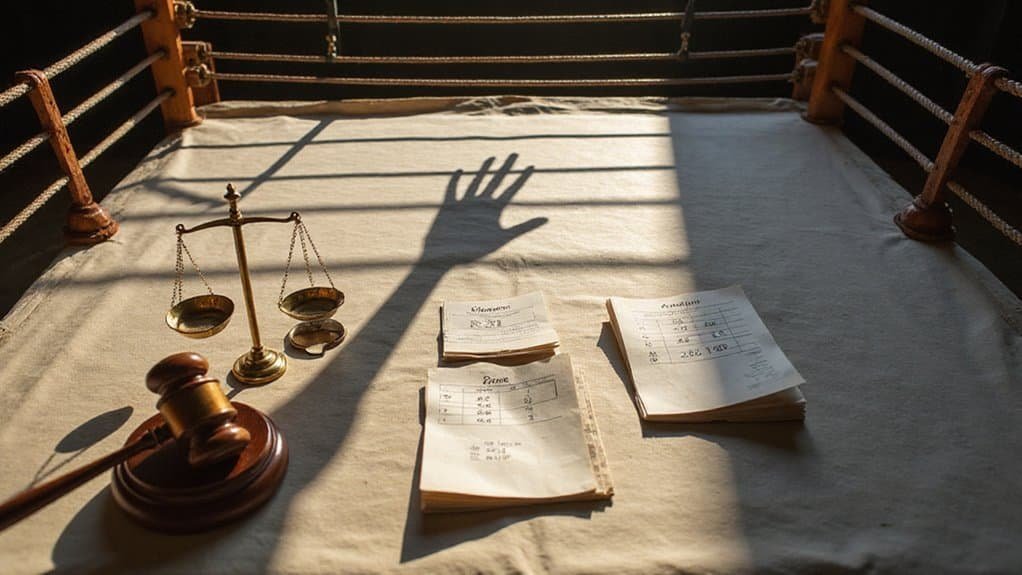A split decision in MMA occurs when two of three judges score the fight for one fighter while the third judge favors the opponent, creating an official victory despite disagreement among the judging panel. This outcome stems from MMA’s 10-point must scoring system, where judges evaluate striking effectiveness, grappling control, aggression, and octagon dominance differently. Split decisions generate significant controversy and debate, often affecting fighter rankings and career trajectories while highlighting ongoing concerns about judging consistency and transparency in mixed martial arts competition.

Controversy follows split decisions in mixed martial arts like shadows trailing fighters leaving the octagon. These outcomes occur when two judges score a bout for one fighter while the third judge awards it to their opponent, creating an official victory despite clear disagreement among the scoring panel.
Split decisions emerge from MMA’s 10-point must scoring system, where round winners receive 10 points and losers typically get 9. Judges evaluate striking effectiveness, grappling control, aggression, and octagon dominance throughout each round. Most rounds produce 10-9 scores unless one fighter demonstrates overwhelming superiority, warranting rarer 10-8 or 10-7 tallies. This standard scoring system ensures consistent evaluation across all professional mixed martial arts competitions.
The subjective nature of judging creates fertile ground for split decisions. Judges interpret scoring criteria differently—some prioritize striking volume while others value grappling control. Their physical positioning around the cage provides unique vantage points that can dramatically influence perception of the action. Close rounds with minimal clear advantage amplify these differences, especially when fighters display evenly matched skills across different martial arts disciplines.
Split decisions differ fundamentally from other bout outcomes. Unanimous decisions require all three judges to agree on the same winner, while majority decisions feature two judges selecting one fighter and a third scoring a draw. Split draws and majority draws represent additional variations in judge consensus, but split decisions uniquely highlight a divided panel’s inability to reach clear agreement.
The frequency of split decisions, while less common than unanimous outcomes, generates disproportionate attention and debate. Historic examples like Gustafsson versus Rua and Bermudez versus Holloway demonstrate how these results spark ongoing discussion among fans, analysts, and fighters themselves. The outcomes carry significant weight beyond bragging rights, directly affecting fighter rankings, title shot opportunities, and career trajectories. High-profile fights often receive intense scrutiny for scoring accuracy and potential judging errors.
Controversy surrounding split decisions reflects broader concerns about MMA judging standards and transparency. Fighters experiencing narrow defeats often feel shortchanged, while narrow victors may question the legitimacy of their wins. Media coverage amplifies these debates, frequently calling for rematches or judging protocol reforms. Contentious fight elements can emerge when judges score according to different personal interpretations of the same action.
The human element in scoring guarantees split decisions remain an inevitable component of mixed martial arts. Judge experience, personal bias, and simple human error contribute to scoring variability that can determine fight outcomes. These factors underscore the inherent challenges in objectively scoring a combat sport that blends multiple fighting disciplines.
Split decisions ultimately represent both the complexity and the imperfection of determining winners in closely contested battles. They remind participants and spectators alike that perception varies, even among trained professionals tasked with objectively evaluating combat performance under the bright lights of professional competition.
Frequently Asked Questions
Can a Fighter Appeal a Split Decision Result?
Yes, fighters can appeal split decision results, but success remains exceptionally rare.
Appeals must be filed within a narrow window—typically 3-10 days—and require evidence of procedural errors or rule violations, not mere disagreement with judges’ scoring.
Out of thousands of professional fights, only approximately four notable cases have been overturned.
Most successful appeals involve clear officiating mistakes rather than subjective judging disputes.
How Often Do Split Decisions Happen in Professional MMA Fights?
Split decisions occur in approximately 13-14% of all professional MMA fights, based on UFC historical data.
This frequency remains relatively stable across divisions, though certain events experience spikes—UFC Fight Night 79 featured a record five split decisions on one card.
These outcomes increase when fights are closely contested with ambiguous rounds that create scoring variance between judges, making split decisions less common than unanimous decisions but more frequent than majority decisions.
Do Split Decisions Affect Fighter Rankings and Title Contention Opportunities?
Split decisions greatly impact fighter rankings and title opportunities.
Close victories provide less ranking momentum than dominant wins, while split losses cause minimal damage compared to clear defeats.
Matchmakers often hesitate to grant immediate title shots after contentious decisions, preferring additional contender fights.
Champions retaining belts via split decision typically face rematch demands, and fighters with multiple split outcomes experience reduced upward mobility.
What’s the Difference Between a Split Decision and a Majority Decision?
A split decision occurs when two judges score the fight for one fighter while the third judge awards it to the opponent.
A majority decision means two judges favor one fighter, but the third judge scores it a draw, not awarding victory to either competitor.
Split decisions create more controversy since judges fundamentally disagree about the winner, while majority decisions show clearer consensus despite one neutral scorecard.

Are There Any Famous Controversial Split Decisions in MMA History?
MMA history features numerous controversial split decisions that sparked outrage.
Georges St-Pierre’s disputed retention over Johny Hendricks at UFC 167 stands out, with many believing Hendricks won.
Al Iaquinta’s victory over Jorge Masvidal drew heavy criticism when 13 of 15 media outlets scored for Masvidal.
Sean O’Malley’s win against Petr Yan and Henry Cejudo, ending Demetrious Johnson’s title reign, remains hotly debated among fans and analysts.

